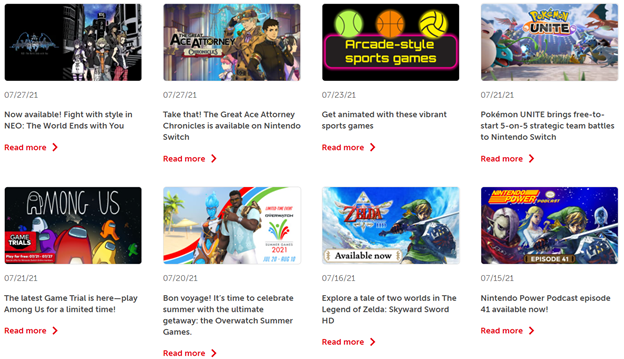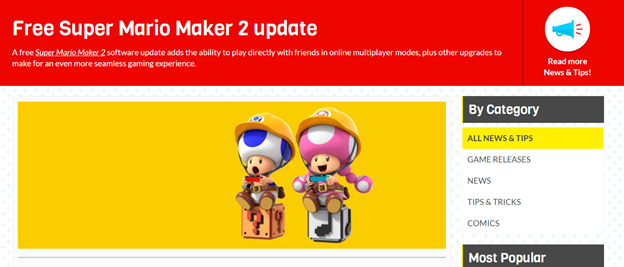Play with Mario, Luigi, Pikachu, and many more! How did these iconic characters win the hearts of many gamers worldwide? [Monday: Marketing Marvels]

The Legend of Zelda.
Pokémon.
Super Mario.
Do you know that despite these games being over 20 years old, these still continue to win the hearts of a lot of video game enthusiasts all over the world even in an ever-changing gaming arena?
How?
To answer this question, let’s take a look at the marketing strategies of the parent company of these video games…
Nintendo Co., Ltd. is a multinational consumer electronics and video game company headquartered in Kyoto, Japan.

Since its founding in 1889, the company has produced some of the most successful consoles in the video game industry such as:
- Game Boy
- Super Nintendo Entertainment System
- Nintendo DS
- Wii
- Nintendo Switch
Nintendo is also the company behind some of the major video game franchises, which include:
- Donkey Kong
- Kirby
- Metroid
- Fire Emblem
- Animal Crossing
- Splatoon
- Super Smash Bros.
… and the 3 games mentioned above.
What are some of the strategies that helped Nintendo maintain consumers’ love for its iconic video games throughout the years?
Aside from Nostalgia Marketing, which we talked about in a previous “Find You Optimization!” article, the company also uses Content Marketing.
Nintendo started using this strategy in 2019 to improve customers’ overall experience after purchasing one of the company’s gaming consoles or game cards.
The brand’s goal?
To provide customers with an awesome gaming experience even after they’ve made a purchase!
Nintendo believes the “selling” process doesn’t end with a sale. Just because someone buys a gaming console or a game card, that doesn’t mean the company’s relationship with that consumer is over.
Nintendo has different strategies to continually keep its customers as supporters!
… and content plays a major role in helping the company do that.
For example:
Nintendo constantly posts updates whenever its games improve gameplay or offer new features. To let gamers know what’s changed in a particular video game, the company releases blog post updates on its website and shares the articles on its social media pages.

That’s why when the “Super Mario Maker 2” released a major update, Nintendo’s content team published a blog post that detailed all the changes to the game.

Thanks to the company’s approach to content, Mario fans and gamers were able to maximize all the new features of Super Mario Maker 2!
Here are 3 other marketing strategies Nintendo employed to make sure its customers get the most out of their gaming experience:
-
Removing silos to create more holistic experiences.
[Business Silo: Refers to business divisions that operate independently and avoid sharing information.]
Nintendo’s empire consists of many games with unique and iconic characters. One of the most engaging aspects of playing these games?
The opportunity to experience brand crossovers!
The company invites players to enter a universe that enables characters like Donkey Kong, Kirby, Link, Pikachu, Mario, and Yoshi to appear and play roles across multiple franchises.
This helps Nintendo establish an experience that allows players to deepen their connections with different game characters.
The crossover strategy was most apparent in the company’s 2018 release of the “Super Smash Bros: Ultimate,” which featured over 80 Nintendo characters that players can use at every level of the game
Here, Nintendo showed that mixing brands doesn’t necessarily water down a game’s value. With the right approach, crossovers help highlight a game’s strengths and other captivating attributes.
-
Sticking to what has always worked for the brand.
The Nintendo Switch is one of Nintendo’s best-selling consoles of all time. In 2020, around 68 million Switch consoles were sold worldwide!
Many consumers attributed the success of the gaming console to a return to Nintendo’s core gaming approach―the Nintendo Entertainment System, Nintendo GameCube, and Nintendo 64.
Aside from that, creating nostalgia through new games and storylines for some of the company’s iconic characters enabled customers to grow with the brand.
By combining the power of nostalgia with consistent functionality (two things that have always worked for the brand), Nintendo was able to create a playing experience that gamers enjoy individually and as a group!
-
Providing experiences that encourage consumers to keep coming back.
In 2020, Nintendo’s sales increased following the rebirth of “Animal Crossing: New Horizons” as a digital game within the Nintendo Switch.
That year, the company sold 26 million units of the game globally!
What was in the game that compelled a lot of gamers to try it out?
One reason was unlike other video games, “Animal Crossing: New Horizons” focused not on winning but on influencing players to:
-
Engage in a fun play.
-
Stimulate their interests without focusing on a single storyline or objective.
Because of this, Nintendo managed to sustain customers’ loyalty to the game because it is more experiential than transactional.
-
Thanks to the help of content marketing and the three other strategies stated above, the company was able to create a holistic experience for its customers and maintain its success as a leader in the video game industry.
In the past five years, Nintendo Co., Ltd. has recorded revenues of:
- JPY 489.1 million in 2017
- JPY 1.1 billion in 2018
- JPY 1.2 billion in 2019
- JPY 1.3 billion in 2020
- PY 1.8 billion in 2021
*Nintendo Co., Ltd. reports full-year earnings every March 31, the end of its financial year.
Clearly, the company’s marketing strategies prove to be effective for the brand as Nintendo constantly recorded higher revenues in the past 5 years.
Nintendo Co., Lts.’s Earning Power: Valens Research vs. As-reported numbers
Nintendo Co., Ltd. (7974:JPN) makes for a great case study that we come back to regularly. One great reason?
The company has proven itself to be a better earning power generator than investors might think.
So, how well has Nintendo been growing its business in the past years?
The research doesn’t lie—nor do the results. Earning power (the blue bars) continues to show results higher on average than what traditional databases show.

The blue bars in the chart above represent Nintendo’s earning power (Uniform Return On Assets). Historically, Nintendo has seen cyclical profitability. Its Uniform ROA ranged from -13% to 285% in the past sixteen years, or a median ROA of 59%. Uniform ROA is at 162% in 2021.
The global ROA is just 6%.
The orange bars are the company’s as-reported financial information. If you relied on these numbers, you will see a company with terribly understated profitability. As-reported ROA (return on assets, a measure of earning power) only ranged from -2% to 19% in the past sixteen years. Its as-reported ROA in 2021 was only at 18%, which is 9 times lower than its Uniform ROA in 2021.
That’s what you’ll see in Yahoo Finance, Google Finance, and most other databases.
The company’s stock price also performed better than the rest of the stock market over the decade, which we can see in the blue line in the chart below. Its returns have been well above the market.

The numbers show that Nintendo has been doing well and making a profit.
According to Doug Bowser, President of Nintendo America, the company’s mission is to put smiles on the faces of its customers.
… and how does Nintendo do that?
By creating “new surprises for people across the world to enjoy together!”
Through this, the company is not just able to share its iconic game characters, but also its creative ideas using video games and the entertainment industry.
The end game?
“Countless and ultimate smiles and enjoyment” to many customers around the world!
About The Dynamic Marketing Communiqué’s
“Monday Marketing Marvels”
Too often, industry experts and the marketing press sing the praises of some company’s marketing strategy.
…Only for the audience to later find out that their product was a flop, or worse, that the company went bankrupt.
The true ROI in marketing can’t be separated from the business as a whole.
What good is a marketing case study if one can’t prove that the company’s efforts actually paid off?
At the end of the day, either the entire business is successful or it isn’t. And the role of marketing is always paramount to that success.
Every Monday, we publish a case study that highlights the world’s greatest marketing strategies.
However, the difference between our case studies and the numerous ones out there, is that we will always make certain that the firm really did generate and demonstrate earning power worthy of study in the first place (compliments of Valens Research’s finance group).
By looking at the true earnings of a company, we can now rely on those successful businesses to get tips and insights on what they did right.
We’ll also study the greatest marketing fails and analyze what they did wrong, or what they needed to improve on. We all make our mistakes, but better we learn from others’ mistakes—and earlier, rather than later.
Hope you found this week’s marketing marvel interesting and helpful.
Stay tuned for next week’s Monday Marketing Marvels!
Cheers,
Kyle Yu
Head of Marketing
Valens Dynamic Marketing Capabilities
Powered by Valens Research
www.valens-research.com







